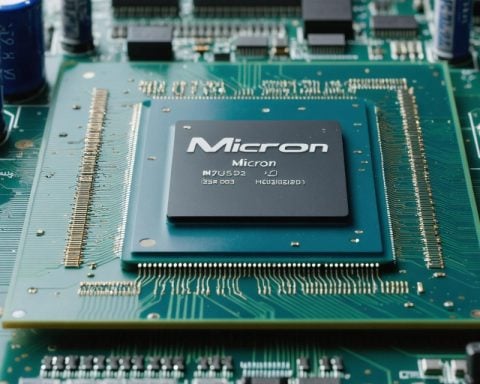- Arm Holdings’ stock soared post-public launch in September 2023, driven by interest in its energy-efficient chips for data centers.
- The company plans to design and sell its own Arm-branded chips, a shift from its traditional licensing model, potentially involving talent acquisition and partnership with companies like Meta Platforms.
- This strategic pivot risks straining relationships with current clients, such as Nvidia and Apple, and may prompt exploration of alternative architectures like x86.
- The move aligns with Masayoshi Son’s vision for AI-driven data centers, but past strategic errors, like SoftBank’s sale of Nvidia shares, cast a shadow.
- The outcome of Arm’s new strategy could redefine its standing in the tech industry, balancing between bold innovation and potential overreach.
In the bustling corridors of the tech world, Arm Holdings has transformed from a quiet powerhouse into a roaring contender. After its public launch in September 2023, Arm’s stock surged from $51 to a jaw-dropping $159, fueled by excitement over its energy-efficient chips gaining traction in data centers. But the company isn’t planning to rest on its laurels.
The seismic shift in Arm’s strategy might just rattle the industry’s tectonics. Instead of sticking to licensing its architecture—a low-risk, capital-efficient revenue stream—Arm aims to design and sell its own Arm-branded chips. This bold leap entails coaxing top talent from its clients and possibly acquiring private chip designer, Ampere, to accelerate the endeavor. It’s rumored that Meta Platforms is already on board as a customer, signaling a potential shift in the data center landscape.
This daring move doesn’t come without its pitfalls. In aligning itself as a direct competitor to its own customers, Arm risks straining relationships with industry behemoths like Nvidia and Apple, who have relied on Arm’s neutral stance. Meanwhile, tech giants might be tempted to explore the competing x86 architecture for future innovations, challenging Arm’s market position.
Beyond corporate strategy, this gamble seems intricately linked to Masayoshi Son’s vision. Driven by an unquenchable thirst for AI dominance, Son envisions a world powered by AI data centers demanding billions in investments. Yet, the shadow of past missteps looms large; SoftBank’s earlier sale of Nvidia shares haunts current decisions.
As Arm ventures into turbulent waters, it beckons the question: Is this bold gamble a strategic evolution or an overcompensation for past misjudgments? While investors watch with bated breath, one certainty remains—Arm’s journey promises to redefine its legacy, for better or worse.
Arm’s Strategic Leap: Disruption or Destiny?
Overview of Arm Holdings’ Strategic Shift
Arm Holdings has embarked on a transformative journey from its traditional business of licensing architectures to designing and selling its own branded chips. This bold strategy may disrupt industry norms and alter its longstanding relationships with clients like Nvidia and Apple.
How-To Steps & Life Hacks
1. Understanding Arm’s New Business Model: Study how Arm intends to transition from licensing to manufacturing, focusing on strategic talent acquisitions and potential partnerships, such as rumored collaborations with companies like Meta Platforms.
2. Adapting to Industry Shifts: Stay aware of changes in data center technology by keeping informed about Arm’s innovations in energy-efficient chips tailored for AI workloads.
3. Positioning for Opportunity: If you’re an investor, analyze market trends and technological advancements to leverage potential opportunities by investing early in companies pivoting toward AI-driven solutions.
Real-World Use Cases
– Data Centers: Arm’s new chips promise increased efficiency, making them appealing for data centers focusing on reducing power consumption and improving performance.
– AI Applications: With Masayoshi Son’s vision, Arm’s chips could be pivotal for AI processing, offering scalable solutions for businesses developing AI models.
Market Forecasts & Industry Trends
Arm’s transition is expected to impact the semiconductor market significantly over the next decade. Analysts predict a market shift towards energy-efficient and AI-optimized chips, with Arm potentially capturing significant market share if successful.
Reviews & Comparisons
Arm-branded chips will likely be compared against traditional x86 processors from competitors like Intel and AMD. Their success will depend on performance benchmarks, compatibility with existing systems, and cost-effectiveness.
Controversies & Limitations
– Customer Strain: Arm’s move to direct sales could strain relationships with existing clients who rely on its architectures.
– Competitive Pressures: As Arm takes on both its customers and competitors, it risks market pushback, with companies possibly opting for other architectures.
Features, Specs & Pricing
While specifics on pricing and detailed specs for Arm’s upcoming chips remain under wraps, expect competitive pricing strategies aimed at penetrating the data center market, emphasizing energy efficiency features.
Security & Sustainability
Arm’s continued commitment to energy efficiency aligns with environmental sustainability goals, reducing the carbon footprint of data centers.
Insights & Predictions
Experts predict that Arm’s shift may inspire other architecture licensors to explore similar vertical integrations, changing the landscape of the semiconductor industry.
Tutorials & Compatibility
Future updates to Arm software developer kits (SDKs) will be crucial in ensuring compatibility across various platforms. Developers should keep an eye on Arm’s SDKs for potential cross-platform optimizations.
Pros & Cons Overview
Pros:
– Potential for significant market expansion in high-growth sectors such as AI and data centers.
– Enhanced product control and innovation capability.
Cons:
– Risk of alienating existing customers.
– Increased operational complexity.
Actionable Recommendations
1. Invest Wisely: Monitor Arm’s stock and market positioning; consider investments if you’re confident in their sustainable energy-focused chip strategy.
2. Stay Informed: Follow industry news and reports on Arm’s developments to keep abreast of how this impacts broader tech ecosystems.
3. Network: If you’re in tech or related fields, networking with industry experts about Arm’s new strategies could open doors to emerging opportunities.
For more on Arm’s future innovations and strategic moves, visit Arm. The ongoing evolution promises to redefine tech landscapes, impacting investment strategies and tech developments globally.























